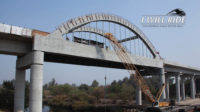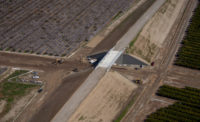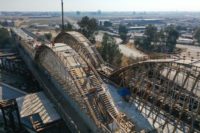$5B Added to California High-Speed Rail Budget in Draft Plan

Construction continues on 119-mile Central Valley segment. Photo courtesy of CHSRA
The California High Speed Rail Authority’s proposed biennial plan paints an optimistic outlook for advancing the delay-plagued 500-mile rail connection between San Francisco to Los Angeles, even as its anticipated cost continues to rise.
According to the Authority’s Draft 2022 Business Plan submitted on Feb. 8 for public review and comment, the price tag for completing the project could top $105 billion, an increase of $5 billion from the 2020 business plan. The authority attributes the added costs to commitments aimed at minimizing community disruption, such as distancing the route from the Cesar E. Chavez National Monument in California’s Central Valley, and the addition of a tunnel near Hollywood Burbank Airport as part of a recently announced 14-mile segment between Burbank and downtown Los Angeles.
The latest estimate is more than twice the $33.6-billion figure presented when voters endorsed a $9-billion bond measure to start construction.
Despite obstacles and waning public and political support, the authority insists that the project has made significant progress over the past decade. Construction is underway on a 119-mile segment in the Central Valley where trains will be tested before additional sections get underway. The authority also expects to receive environmental clearance on all but approximately 80 miles of the total route by this summer.
In addition, the authority cites a wider range of potential funding sources available with last year’s passage of the bipartisan infrastructure bill, which could open the door to as much as $6 billion in new federal grants. The Biden administration has also restored $1 billion in federal support that was rescinded during the Trump Administration. Funding could also come from Build Back Better bill currently before Congress.
Gov. Gavin Newsom (D) has once again proposed releasing the remaining $4.2 billion from the 2008 bond—a move that the state legislature rejected last year—as part of a $15 billion transportation program announced last month. The project also receives revenue from California’s carbon cap-and-trade program.
In a statement issued with release of the draft business plan, the authority sees “a tremendous opportunity” to develop a federal-state funding program that will deliver a two-track initial operating segment connecting Merced, Fresno and Bakersfield, and begin engineering and design work on other sections as they receive environmental clearance.
The statement adds that new funding would also enable the authority to make targeted statewide investments in shared corridors that “provide immediate benefits to existing operators and prepare these corridors for statewide high-speed rail service,” and advance a longer-term funding strategy to extend high-speed rail beyond the Central Valley as soon as possible.





